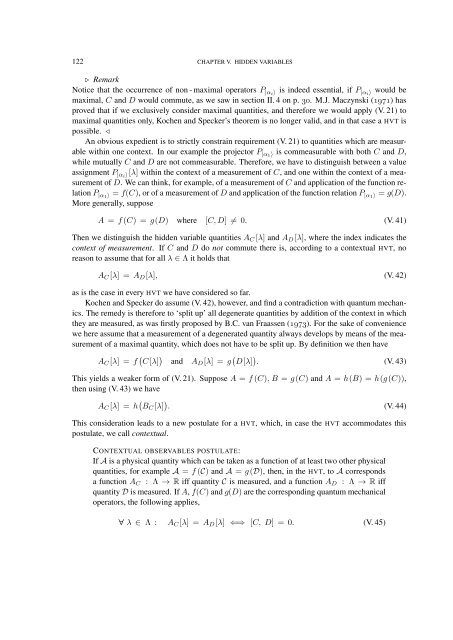FOUNDATIONS OF QUANTUM MECHANICS
FOUNDATIONS OF QUANTUM MECHANICS
FOUNDATIONS OF QUANTUM MECHANICS
Create successful ePaper yourself
Turn your PDF publications into a flip-book with our unique Google optimized e-Paper software.
122 CHAPTER V. HIDDEN VARIABLES<br />
◃ Remark<br />
Notice that the occurrence of non - maximal operators P |αi ⟩ is indeed essential, if P |αi ⟩ would be<br />
maximal, C and D would commute, as we saw in section II. 4 on p. 30. M.J. Maczynski (1971) has<br />
proved that if we exclusively consider maximal quantities, and therefore we would apply (V. 21) to<br />
maximal quantities only, Kochen and Specker’s theorem is no longer valid, and in that case a HVT is<br />
possible. ▹<br />
An obvious expedient is to strictly constrain requirement (V. 21) to quantities which are measurable<br />
within one context. In our example the projector P |α1 ⟩ is commeasurable with both C and D,<br />
while mutually C and D are not commeasurable. Therefore, we have to distinguish between a value<br />
assignment P |αi ⟩[λ] within the context of a measurement of C, and one within the context of a measurement<br />
of D. We can think, for example, of a measurement of C and application of the function relation<br />
P |α1 ⟩ = f(C), or of a measurement of D and application of the function relation P |α1 ⟩ = g(D).<br />
More generally, suppose<br />
A = f (C) = g(D) where [C, D] ≠ 0. (V. 41)<br />
Then we distinguish the hidden variable quantities A C [λ] and A D [λ], where the index indicates the<br />
context of measurement. If C and D do not commute there is, according to a contextual HVT, no<br />
reason to assume that for all λ ∈ Λ it holds that<br />
A C [λ] = A D [λ], (V. 42)<br />
as is the case in every HVT we have considered so far.<br />
Kochen and Specker do assume (V. 42), however, and find a contradiction with quantum mechanics.<br />
The remedy is therefore to ‘split up’ all degenerate quantities by addition of the context in which<br />
they are measured, as was firstly proposed by B.C. van Fraassen (1973). For the sake of convenience<br />
we here assume that a measurement of a degenerated quantity always develops by means of the measurement<br />
of a maximal quantity, which does not have to be split up. By definition we then have<br />
A C [λ] = f ( C [λ] ) and A D [λ] = g ( D[λ] ) . (V. 43)<br />
This yields a weaker form of (V. 21). Suppose A = f (C), B = g(C) and A = h(B) = h(g(C)),<br />
then using (V. 43) we have<br />
A C [λ] = h ( B C [λ] ) . (V. 44)<br />
This consideration leads to a new postulate for a HVT, which, in case the HVT accommodates this<br />
postulate, we call contextual.<br />
CONTEXTUAL OBSERVABLES POSTULATE:<br />
If A is a physical quantity which can be taken as a function of at least two other physical<br />
quantities, for example A = f (C) and A = g (D), then, in the HVT, to A corresponds<br />
a function A C : Λ → R iff quantity C is measured, and a function A D : Λ → R iff<br />
quantity D is measured. If A, f(C) and g(D) are the corresponding quantum mechanical<br />
operators, the following applies,<br />
∀ λ ∈ Λ : A C [λ] = A D [λ] ⇐⇒ [C, D] = 0. (V. 45)
















